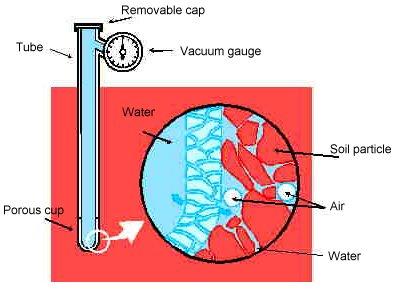Explaining tensiometers
Tensiometers are simple and reliable tools used to monitor and maintain optimum soil moisture levels. A tensiometer is a liquid filled hollow tube with a porous ceramic cup at one end and a sealed cap at the other (Figure 1).
As plants use water and the soil dries out, water is drawn out of the tensiometer through the porous ceramic tip, creating a vacuum inside the tube. A vacuum gauge can be attached for manual measurement or a remote sensing unit will allow continuous logging of tension in the soil.
The suction is measured in kilopascals (kPa) with zero representing a wet or saturated soil and a drying soil moving away from zero. At low readings (such as 10kPa), it is relatively easy for plants to get water from the soil. The higher the reading (such as 35kPa), the drier the soil and the harder it is for plants to take up water.
Using tensiometers
Soil moisture sensors need to be installed and positioned correctly to be useful. Testing irrigation equipment at the start of the season to check water is delivered evenly and efficiently and to determine the average application rate being delivered is vital.
Install tensiometers shortly after emergence between healthy, average-sized potato plants in the middle of the hill and in a site which is representative of the whole field. A minimum of two tensiometers should be installed, one at 30cm and another at 45-50cm, depending on the depth of any clay layer. These two tensiometers together make up a station.
Install one or two stations for each crop of the same age and variety. Crops planted on different sides of a hill should have one tensiometer station installed on either side.
Use of modern systems will allow for continuous logging (each 15 to 30 minutes) and give true water status of the soil. The chart formed will show periods of high demand, low water use and most importantly, stress. See Soil moisture monitoring to fine-tune irrigation scheduling for further information.
If taking readings from a manual gauge it is preferable to take them at the same time each day, usually in the morning. If it is the first time using tensiometers, taking readings a few times a day for a day or two will show if the readings are varying much during the day as plant water use increases.
It may only be necessary to take readings every two days in medium to heavy soils and every day on lighter soils. Recording the readings on graph paper will allow you to see when available soil moisture is becoming low and tension is increasing.
The 30cm tensiometer is used primarily to schedule irrigations. Begin irrigating when the gauge on the 30cm tensiometer reaches the trigger points shown in Table 1 for each variety. A rule of thumb is for the first one or two irrigations, the amount of water applied should equal the trigger point readings on the 30cm gauge, as in Table 1.
If the 30cm tensiometer reading was 25kPa, apply 25mm of water to recharge the crop root zone. Subsequent irrigations can be more closely monitored by observing the readings on the deeper tensiometer. Irrigation should not be allowed to cause the deeper tensiometer reading to fall below 10-12kPa or become too wet. Apply more water if the reading on the 30cm tensiometer does not change.
By tracking evaporation or evapotranspiration the amount of water required to refill the profile and when this may be required can be predicted. See Evaporation based irrigation scheduling for more information.
Allow at least 24 hours after irrigation for water to reach the porous cup of the deeper tensiometer before taking a gauge reading.
| Variety | Gravelly loams and clay | Loamy sands |
|---|---|---|
| Delaware, Nadine* | 20kPa | 15kPa |
| Russet Burbank | 25kPa | 20kPa |
| Atlantic, Cadima, Kennebec, Nooksac | 30kPa | 25kPa |
* suggested trigger point for Nadine
Acknowledgement
The original version of this material was authored by Murray Hegney and Harald Hoffman.

